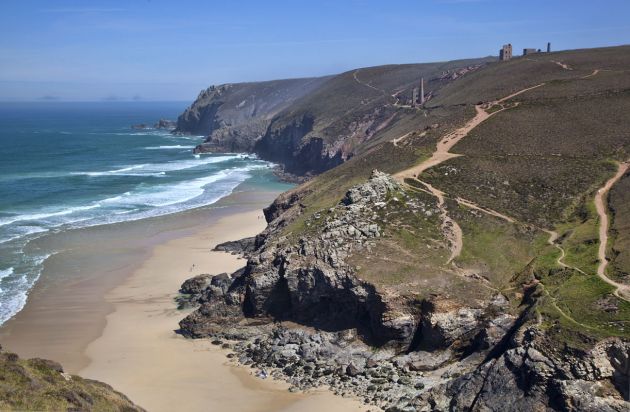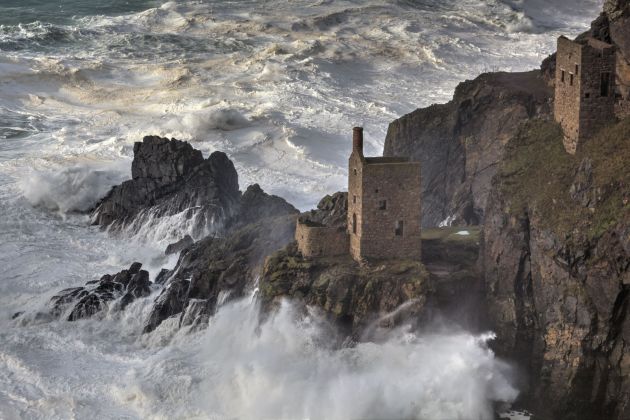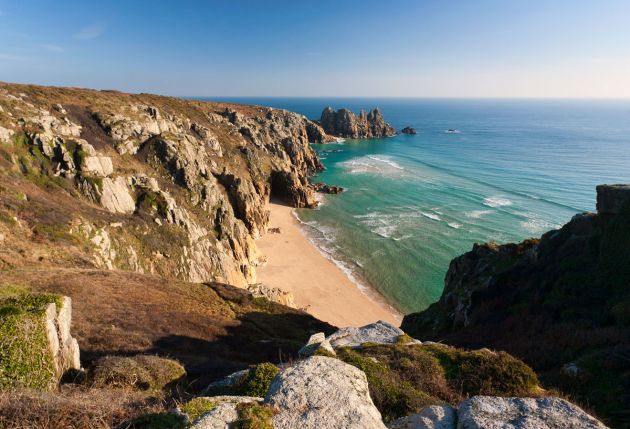Complete guide to film locations 2015-2018
As season 4 of Poldark draws to an end I have finally pulled my finger out to provide a thoroughly comprehensive guide to the filming locations used throughout this latest epic TV dramatisation of Winston Graham’s novels. In theory I should have been the first to put together this list as one of my oldest friends was the Cornwall location manager! But then again back in 2015 it was hard to predict quite what a massive hit the series was going to be, and quite what effect it was to have on tourism in Cornwall.
In fact this isn't the first television adaptation of the Poldark novels. Back in the 1970s an almost equally well received series was aired and many of the same locations were featured. Obviously it's a winning formula; a rip-roaring period drama set against the backdrop of Cornwall's stunning scenery.
So, without further ado, here is the list of all the Poldark film locations in Cornwall (Some scenes were filmed elsewhere).
Charlestown
The Grade II listed Georgian port of Charlestown, near St Austell, has been a favourite filming location for years and it's easy to see why with its long granite quays and unspoilt backdrop. Add to this the fact it is home to a fleet of sailing ships and you have the perfect setting for an 18th century drama.
Charlestown was used in the 1970s Poldark series so it is no surprise to see it appearing once more. In the first two series Charlestown was used for all the harbour scenes which included portraying Truro and Falmouth. One of the most notable scenes from Series 1 filmed here was Verity Poldark and Captain Andrew Blamey eloping, much to the consternation of her family.
The small beach alongside the harbour in Charlestown was also used in filming where it doubled as St Mary's on the Scilly isles where Ross meets the exiled Mark Daniel.
In 2018 the privately owned harbour was sold by Square Sail to Sir Tim Smit, the founder of the Eden Project.
Turnaware Point (River Fal)
Set just across the broad waters of the River Fal from the rolling parkland of Trelissick House is the wooded headland of Turnaware Point. This area, known as the Roseland, is strikingly different in terms of scenery to much of the rest of Cornwall, and perhaps this is why it was chosen to represent another country.
In Series 3 the riverside location is used as the landing spot for Ross' rowing boat when he travels to France in an ill-fated mission to rescue his friend, Dr Dwight Enys, from a French Prison.
It is perhaps a little ironic that Turnaware Point was used to represent France as it was previously best known as one of the secret embarkation points for the D-Day landings in Normandy.
Bodmin Moor
The bleak beauty of Bodmin Moor is Cornwall's true wilderness. It is one of the few places that even in the middle of summer you can get away from it all. The expanse of moorland with its rocky tors is punctuated by the occasional village consisting of a huddle of solidly built granite cottages. It is one of these in St Breward that was used for filming exterior shots of the Poldark family home, Nampara. The location for "Poldark Way" was also near here.
The village of Minions on the southern side of the moor was also used in several scenes in Series 1. The rugged moorland here which is well-known for its stunning rock formations and stone circles features in a number of horseback scenes between Trenwith and Nampara. Minions is also the location of a number of miner's cottages such as the one gifted to Jim and Jinny Carter by ross.
Bodmin Jail
Until relatively recently Bodmin was the county town of Cornwall and home to not only the county court but a notorious prison. Built in 1778 the austere and imposing building served as a jail until 1927. During this time it was the site of a significant number of executions which has perhaps lead to the prison becoming known as Cornwall's most haunted place.
It seems fitting that Bodmin Jail was used for filming the incarceration of Jim Carter in Series 1. Ross' farmhand is thrown into jail when he is caught poaching but the conditions here are so bad that he dies soon afterwards.
The jail is currently open to the public as a museum where you can view recreations of prison life and see the "execution pit" where prisoners were hung. There are also a number of ghost tours of the prison. At present there is talk of developing the prison building into a luxury hotel, although plans include preserving the museum.
St Agnes Head & Chapel Porth
The dramatic clifftop scenery and iconic engine houses of this section of the North Cornish coast have served as a backdrop for many a horse riding scene all through the Poldark series. The cliffs here are home to one of Cornwall's best known old mining engine houses - Wheal Coates - which was a well known view long before the latest Poldark adaptation.
Located just a stone's throw from Perranporth, the home of Poldark author Winston Graham, this is quite possibly the very terrain Graham pictured as he wrote his novels. In the TV adaptation the cliffs were used to film Nampara Valley, featuring in many a horseback scene. The backdrop of Wheal Coates was used as Wheal Grace.
Holywell Bay
Also situated not far from the author's home is Holywell Bay. Now owned by the National Trust this wide expanse of golden sand backed by grass-tufted sand dunes is instantly recognisable by the towering twin rocks which lie just off the coast.
This dramatic backdrop was not lost on the Poldark team and it features as Warleggan's beach in the second series. Basically if it features a wide, windswept beach with crashing waves, it was probably filmed at Holywell.
Think horses galloping across the sands (Dwight Enys and Caroline Penvenen racing), romantic walks with Demelza, but most of all think of a topless, dripping Ross emerging from the waves.
Park Head
If you came to Cornwall looking for stunning coastal scenery then you couldn't do much better than Park Head between Newquay and Padstow. The dramatic sheer cliffs here have the iconic sea stacks of Bedruthan Steps as a backdrop making for some of the best clifftop views in Cornwall - something that wasn't lost on Poldark's location managers.
In Series 2 of Poldark there are a few scenes of Ross on horseback galloping across the grassy clifftop here. There is also a scene with Demelza walking the cliffs alone with Bedruthan Steps in the background.
Porthcothan Beach
Just beyond Park Head is the sandy cove of Porthcothan which featured in the first and second series as the Poldark family owned "Nampara Cove". Here we see Ross galloping across the sands of Porthcothan and neighbouring Hendrawna on horseback.
A few swimming scenes were also shot at the southern end of the beach where a natural lagoon is formed in the lee of the Trescore Islands.
Padstow area
Whilst none of the actual Poldark filming so far has taken place in Padstow itself, the beautiful cliffs and nearby beaches featured.
Stepper Point, a few miles north of Padstow, stands guard to the mouth of the Camel Estuary with a small granite tower acting as a daymark to boats. This was used as the backdrop to a scene involving horse-drawn carriages racing across the clifftop. In the background was the mouth of the estuary and beaches beyond.
The sheltered beaches of Tregirls and Hawker's Cove that sit in the shelter of Stepper Point have also made appearances in the third series.
Botallack
Perhaps the standout location of the TV adaptation of Poldark has been the St Just section of the Cornish Mining World Heritage Site, and in particular Botallack. It is here (with a little help from some computer generated renovation) that the bulk of the mining activity takes part in the series. Back in the 1870s this was at the centre of the Cornish tin industry and over 500 people worked here.
Botallack is home to what is perhaps the most iconic of Cornish engine houses, The Crowns. Perched at the bottom of rugged cliffs, barely above the sea sit a pair of granite engine houses. The reason for their precarious position, the mine shaft goes from here and over mile out under the often tempestuous Atlantic Ocean.
In the Poldark series the Crowns were used as Grambler mine with a bit of CGI adding a roof or two and some additional workings.
The location used for Wheal Leisure is just next door to the Crowns, and part of the same mine complex. Wheal Owles West sits on top of the Botallack cliffs and is a well preserved engine house with a very dark history. Like the Crowns, the mine shaft at Wheal Owles went out far and deep under the sea. In the winter of 1893 a group of miners working deep under the sea bed accidentally broke into the abandoned workings of Wheal Drea. The old mine was flooded and the water gushed into Wheal Owles drowning 20 miners in the process.
Levant Mine
Whilst the exterior shots of the old mines required a little computer enhancement this wasn't the case for the workings of the Tressiders Rolling Mill. This was where the copper produced by the Poldark family's mine went for processing and Levant mine, just along from Botallack was used for this.
Levant is owned by the National Trust and is home to one of the few working steam beam engines in existence. A scene in the second series was shot here involving Ross and Francis Poldark discussing the whether the engine lived up to its inventor's (Richard Trevithick) claims.
As with the other mines along this coast Levant's shafts went far and deep under the ocean. In 1919 the mine was the scene of one of Cornwall's worst ever mining disasters when the lift mechanism in the 1,800 feet deep shaft collapsed. 31 miners were killed with many more injured as the lift smashed down the shaft. Many of the bodies were never recovered and the lower levels of the mine weren't worked thereafter.
Penberth Cove
The idyllic little fishing hamlet of Penberth lies in a hidden valley between Lamorna and Porthcurno. With its clutch of granite cottages, cobbled slipway and working capstan it must have seemed like an obvious choice for Poldark.
Penberth Cove has become Sawle village in Poldark, home to Demelza's two brothers, Sam and Drake Carne. As such it has featured in many scenes involving Demelza and Doctor Enys.
As far as I know the cove did not appear in the first series but has been in every one since.
Porthgwarra
Porthgwarra was something of an unknown until Poldark blasted it on to the map. Living less than 10 miles away myself it was many years before I decided to see what was down the lane beyond Porthcurno. When I finally did drive that extra mile I was rewarded with a lovely, but quirky, little cove.
The (usually) sandy beach here is backed by a particularly steep slipway. Next to this is a rocky outcrop into which a couple of tunnels have cut. These were built so that the local farmer could more easily load his cart with seaweed from the beach and the fishermen had access to the other side of the beach.
Porthgwarra is where one of the most memorable scenes from the first series of Poldark was shot. This is the scene in which Ross goes skinny-dipping in the crystal clear waters off the beach, whilst Demelza secretly looks on from the cliffs above.
Porthcurno and Pedn Vounder
Porthcurno beach has long been one of the most photographed spots on the Cornish coast. With its crystal clear turquoise waters, near white sand and rugged cliffs it isn't hard to see why. This iconic natural beauty has not been lost on the region's location managers either. Porthcurno was intended to feature in the original 1970s Poldark series but the film crew had to rethink after the often lively seas here didn't cooperate.
In Series 1 of Poldark Porthcurno and neighbouring Pedn Vounder beach featured as the fictional "Nampara Cove". Most notable of these scenes is a dream sequence in episode 2 where Ross and Demelza walk across the beach towards the cliffs of Treryn Dinas.
Unfortunately these two beaches (which are joined at low tide) seem to have become something of a victim of their own success. In fact, in the summer of 2018 the Cornish tourist board took the step of claiming they weren't promoting this location anymore as it had reached saturation point. Also, some cheeky visitors had the audacity to complain about the nudists on Pedn Vounder - fact is they have been there far longer than Poldark was ever televised.
Gwennap Head
In a land of rugged headlands Gwennap Head is one of the more rugged. Situated on the south coast somewhere between Porthgwarra and Land's End this is a notorious section of the coast. About a mile off the cliffs here lie the Runnelstone reef which have claimed numerous ships over the years. For this reason the headland is now the site of a Coastguard lookout along with a pair of curious looking daymarks which resemble some kind of modern art installation!
Strange objects aside the coastline here makes a particularly dramatic backdrop. Being only a few minutes trot from Porthgwarra it would make sense for Aidan Turner to dry off from his skinny-dipping and jump on the back of his trusty steed, Seamus for some clifftop gallops.
Kynance Cove
Located near the southern tip of Cornwall at the Lizard Point is the spectacular Kynance Cove. The cove here is both beautiful and instantly recognisable with its intriguing rock formations. Towers of serpentine rise out of the near white sand and crystal clear turquoise waters to form one of the most iconic locations in Cornwall.
It's not hard to see why Poldark's filmmakers were drawn to the National Trust owned beach and it appears in the series as Nampara Cove. There are a few notable scenes filmed here including Demelza and Ross landing their fishing boat in rough seas. The clifftops were also used in a the scene involving Ross being marched to jail in Truro in Series 2.
However, like the equally stunning Porthcurno, Kynance also suffered from the "Poldark effect" with the cove becoming so overrun during the summer of 2018 that the tourist board took the unprecedented step of asking Poldark fans to stay away.
Gunwalloe
Another Lizard Peninsula location used throughout the Poldark series are the beaches at Gunwalloe. This sandy Church Cove first made an appearance early in Series 1 where it was the scene of a night time shipwreck. Perhaps the inspiration for the location came from the fact that the shifting sands here were already the site of the wreck of the 17th century Schiedam.
Just around the corner is another cove with a shipwreck related past, Dollar Cove, also known as Jangye Ryn. It is said that silver dollars were washed ashore from a Portuguese ship that went down here in the 17th century. In series 2 of Poldark there is plenty of action at Dollar Cove with smugglers thwarted by the Customs officers and soldiers.
The exterior of Dr Dwight's cottage was also filmed near Gunwalloe, just along the coast at Fishing Cove which stretches off towards the infamous Loe Bar.
Predannack Wollas
To be honest I hadn't heard of Predannack Wollas until it became one of the Poldark filming locations. In fact I doubt any of the numerous websites writing about Predannack Wollas as if it were some well-known beauty spot had either. That's not to say I hadn't been here a few times - I had, but always thought of it as the bit between Mullion and Kynance coves. Anyway, now thanks to Poldark it has a name!
This is a lovely stretch of coast though, with views out over Mount's Bay and the Mullion Island. The exposed clifftop heathland is punctuated with rocky outcrops and patches of wild flowers making it the ideal backdrop for some of Poldark's full throttle horseback scenes.
Poldark Mine

Poldark Mine has long been part of the Cornish tourist trail. Located just outside Helston the site was originally named Wendron Forge when it opened in 1972 and was run as a mining museum / gardens. At this time the owners had no idea that there was even a mine on the site. it was more or less by accident that the long forgotten workings of the 18th century Wheal Roots were discovered a few years later. After much work to pump out and make the mine safe some of the underground workings were opened up to the public. Not one to miss an opportunity the then owner Peter Young sought permission from Winston Graham to name the mine Poldark, which had just become a hit TV series.
The mine's links with Poldark grew from here and it was used for some of the underground sequences of the 1977 series of Poldark. Winston Graham actually launched some of the Poldark books at Poldark Mine including the final novel in 2002, not long before his death in 2003. There is also a memorial to Angharad Rees here; she starred as Demelza in the original series and was a regular visitor to the park.
It seems quite fitting that the latest adaptation of Poldark has also used Poldark Mine as a location for underground scenes. This does make sense as the mine here is true to the period, unlike more recent excavations such as Geevor near Botallack.























